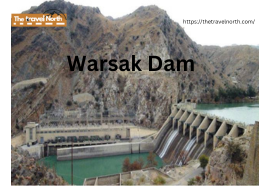Warsak Dam, located on the Kabul River in Khyber Pakhtunkhwa, Pakistan, is a major hydroelectric project that plays a crucial role in power generation, irrigation, and water management. Surrounded by rugged mountains and stunning landscapes, the dam is not only an engineering marvel but also a scenic destination worth visiting.
If you’re interested in Pakistan’s energy infrastructure, water conservation, or simply want to explore a breathtaking location, Warsak Dam offers a unique blend of technology, sustainability, and natural beauty.
History and Construction of Warsak Dam
When Was Warsak Dam Built?
The construction of Warsak Dam began in the 1950s with funding and technical assistance from Canada under the Colombo Plan. The first phase was completed in 1960, and later, additional turbines were installed in 1980 to enhance its electricity production capacity.
Purpose Behind the Project
Warsak Dam was primarily built to generate hydroelectric power and meet the increasing energy demands of Pakistan. Over the years, it has also played a significant role in water storage, irrigation, and flood control, benefiting local communities and agriculture.
Hydroelectric Power Generation at Warsak Dam
How Much Power Does Warsak Dam Generate?
The dam has an installed capacity of 243 MW, making it a key contributor to Pakistan’s electricity grid. It operates using hydroelectric turbines, harnessing the natural flow of the Kabul River to produce clean and renewable energy.
Why Is Warsak Dam Important for Pakistan’s Energy Sector?
Pakistan faces frequent power shortages, and hydroelectric dams like Warsak play a vital role in reducing dependency on fossil fuels. Since hydroelectric power is sustainable, cost-effective, and environmentally friendly, Warsak Dam helps promote green energy solutions in the country.
Warsak Dam’s Role in Irrigation and Water Management
How Does the Dam Support Agriculture?
Water stored in Warsak Dam is used for irrigation, benefiting farmers and agricultural lands in surrounding regions. The controlled release of water helps ensure steady crop production throughout the year.
Flood Control and Water Storage
During the monsoon season, the dam helps regulate water flow, preventing flood-related disasters in downstream areas. This makes it a critical component of Pakistan’s water management infrastructure.
Scenic Beauty and Tourism at Warsak Dam
A Beautiful Destination for Nature Lovers
Warsak Dam is surrounded by majestic mountains, clear blue waters, and lush greenery, making it a great place for tourists, photographers, and nature enthusiasts. If you love peaceful environments, this location is a must-visit!
Recreational Activities Near Warsak Dam
Visitors to the dam can enjoy:
Boating and fishing in the reservoir
Picnics and family outings with breathtaking views
Photography and sightseeing of the surrounding landscapes
Can You Visit Warsak Dam?
Since Warsak Dam is a strategic energy facility, visitor access may be restricted at times. However, with special permission from relevant authorities, you may be able to explore certain areas of the dam.
Challenges and Future Prospects of Warsak Dam
Challenges Faced by the Dam
Like many older hydroelectric projects, Warsak Dam has faced silt accumulation and efficiency issues over the years. Regular maintenance and upgradation are needed to keep the dam fully operational.
Future Expansion and Upgrades
There have been discussions on upgrading Warsak Dam to enhance its power generation capacity. With new technologies and modernization efforts, the dam could contribute even more to Pakistan’s renewable energy production.
Conclusion – Why Warsak Dam Matters
Warsak Dam is more than just a power plant—it’s a lifeline for energy, agriculture, and water management in Pakistan. Its hydroelectric power reduces energy shortages, supports irrigation, and helps prevent floods, making it an invaluable asset to the nation.
Beyond its technical importance, the dam’s stunning surroundings and peaceful environment make it a scenic wonder. Whether you’re interested in renewable energy, nature, or engineering marvels, Warsak Dam remains a significant landmark in Pakistan’s infrastructure and landscape.




